"Scorpion": an interceptor with a nuclear missile. Part I
In the air of one of the remote sites in the state of Nevada 19 June 1957, a silver interceptor appeared with identification marks of the air defenses of the US Air Force. The operator of the two-seat fighter reported to the pilot that there were no other planes over the desert. The pilot pressed the start button, and a large rocket fell off the interceptor pylon and went forward. Outwardly, everything looked as usual rocket weapon for air combat by that time ceased to be exotic. However, a few seconds after launch, a fireball exploded over the desert, and registration devices recorded a nuclear explosion with a powerful shock wave. On this day, the Americans first tested in real flight a nuclear air-to-air missile Douglas MV-1 Jenny. The F-89J Scorpion interceptor aircraft ushered in an era of combat aviation with nuclear weapons of air combat.
23 March 1945, the US Army Air Force announced a competition to replace the Northrop P-61 Black Vision night fighter. It was supposed to adopt an all-weather interceptor capable of covering the northern US air defense sector, in particular, Alaska. Originally it was planned to create a fighter with a piston engine, but in December 1945, the army changed its requirements - now only a jet plane was required.
Bell, Convair, Douglas, Goodyear, Curtiss-Wright and Northrop made their proposals for the competition. The Convair proposal was the most unusual - the delta-wing interceptor, later embodied in the F-102. Douglas offered a modified version of the XF3D-1 Skylight all-weather interceptor deck. The Curtiss project, the HF-87 Blackhawk, was a large two-seater aircraft. By the number of engines - four pieces - this fighter entered the Guinness Book of Records. Despite the fact that the story about it is beyond the scope of the article, I think that XF-87 deserves to be told a little more in detail about it.
This aircraft was the first and only purely jet fighter of the Curtiss company, as well as the last aircraft manufactured by this company. Curtiss Wright Corporation, like all aircraft manufacturers in the United States, faced a massive reduction in orders since the end of World War II. Unfortunately, the company did not have orders in its “portfolio” for the post-war civilian market, and all contracts for its combat aircraft were canceled. In 1946, Curtiss-Wright closed all of its assembly lines, with the exception of the government-owned Columbus plant, which was building for fleet SB2C "Helldiver". All divisions of the aircraft manufacturing department of the company were transferred to Columbus to concentrate forces in order to return to the aircraft market. Indeed, after success with the R-40 fighter and the deck-based SV2C Helldeiver, Curtiss fell into a zone of continuous failure. Among them were experimental aircraft for the US Army Air Force XP-46, R-60 and XP-62 and for the fleet XF14C, XBTS-2 and XBT2S-1 - not one of them went into the series. However, by the time the competition for the all-weather interceptor was announced, the company already had its own project presented to the army, bearing the corporate designation “model 29”. The jet was specially designed for the role of an attack aircraft, so the army even gave the designation HA-43 to the two experimental prototypes ordered. For the new requirements for a night fighter, the company introduced a modified version of the “model 29” of the same layout. The project received the designation "Model 29A." The army ordered two prototype aircraft that received the designation XP-87 Blackhawk.
Army aircraft initially favored the Curtiss project, moreover, this was the only chance not to close the last Curtiss-Wright aircraft factory. In order to facilitate the task to the designers of Curtiss, the order for the XA 43 21 attack aircraft on November 1945 G was canceled, and the aircraft’s means and serial numbers went to the XP-87 project.
The XP-87 was a large, all-metal sredneplan under the four engines Westinghouse XJ34-WЕ-7 kg 1362 kg, assembled in two packages under the wing. The stabilizer was mounted in the middle of the keel. The aircraft had a tricycle landing gear. The pilot and radio operator were located nearby in a large, spacious cockpit. The armament was to consist of a nose and tail turret, with a pair of 12,7-mm machine guns in each. Additionally, the aircraft was planned to be equipped with retractable missile launchers. However, it was soon decided to replace the armament with four 20-mm guns in the nose turret, which was to be developed on the Glenn L. Martin Company from Baltimore. The turret was supposed to provide declination angles of the guns from 0 to 90 °.
The take-off weight of the XP-87 was estimated at 22246 kg - this was supposed to be one of the heaviest Curtiss aircraft, with the exception of some models of the twin-engine C-46 “Commando”.
Experienced XP-87 was ready at the start of 1948. In March, 1948, he was transported to the Murok airbase. The first flight took place on 5 March. The XP-87 flight data (renamed 1948 g to XF-87 in June) was initially considered promising, although the maximum speed turned out to be 12% lower than expected, and the high-speed rafting was revealed. As a result of June 10 1948, an order was placed for the 57 F-87А and 30 RF-87 photo reconnaissance aircraft.
Since the XF-87 motors were clearly lacking, it was planned to install two engines General Electric J87-GE-47, 7 kg, for serial F-2724А. These engines were supposed to put on the second experienced XF-87 (46-522), renamed respectively XF-87A.
After concluding the contract for F-87, it seemed that the post-war problems for Curtiss-Wright were over, but the USAF chose the Northrop XF-89 Scorpion as the more promising all-weather interceptor, and the order for the Р-87А was canceled for October 10 1948. Work on the twin-engine XF-87A stopped before its final assembly.
The loss of the F-87 contract was for Curtiss-Wright the final blow, which showed the complete failure of its designers. With no more orders, Curtiss-Wright was forced to close its aircraft building department, which simply sold North American Aviation, and the plant in Columbus was returned to the US Navy.
Nortrop presented its N-24 project to the competition. This project was a sredneplan with a long, narrow fuselage. A non-swept wing should have a laminar profile and was specifically designed to ensure low landing speed for landing in bad weather conditions. At the tips of the planes could hang a large fuel tanks. The plane was planned to be equipped with two turbojet Allison J35 engines with afterburner chambers. The engines were placed nearby, under the fuselage so that the air intake channel was, as far as possible, straight. In the pressurized cabin, a pilot and a radio operator were located on ejection seats under a large, backward moving flashlight. The stabilizer was mounted in the middle of the keel and did not fall under the exhaust jet of the engine. The nose landing gear was very short and carried a twin wheel. The main racks were distinguished by large tires, unusually looking at an experienced car.
Since the car was supposed to be an all-weather interceptor, a search locator was installed in its nose. The aircraft’s armament was planned from four X-NUMX-mm M-20 cannons in the nose turret. Two variants of the tower installation were considered: the Martin's tower allowed the cannon barrels to be removed into the nose of the fuselage and brought into a combat position only at the moment of firing, at an angle of fire of 24 ° and a declination of 360 °; the other tower, Northrop, was similar to Martin’s design, but had a smaller declination angle, 105 °.
The Army Air Force well accepted the Northrop project and the 3 of May 1946 signed a contract for the aircraft design. In December, under the designation XP-89 ordered two prototype aircraft.
By that time, the Cold War between the West and the Soviet Union was gaining momentum. It was clear that the creation by the Soviet Union of a nuclear bomb was only a matter of time. In 1947, a Tupolev Tu-4 bomber was shown at the Tushino air parade, which shocked American intelligence, as the USSR now theoretically gained the ability to launch nuclear strikes directly on the territory of the United States. At the same time, the level of development of US air defense did not allow them to effectively counter a new threat. An all-weather interceptor was urgently needed, which could be released in sufficient quantities before the appearance of nuclear weapons in the USSR.
We needed a plane for the immediate equipping of air defense squadrons. As the Curtiss-Wright interceptor, the Northrop interceptor could only be obtained in sufficient numbers in a few years. The US Air Force in March 1948 proposed to Lockhid to develop an all-weather fighter based on the two-seat training TF-80С, the start of deliveries of which, to combat units, could be expected until the end of 1949. Lockheed quickly accomplished this task by launching the Starfire F-94 fighter.
The first Northrop XP-89 was taken out of the hangar in June 1948. The aircraft was equipped with a pair of engines Allison J35-A-9-15, 1860 kg each. Since the tower installations were not yet ready, there was no weaponry on the test aircraft. In addition, the XP-89 could not yet carry fuel tanks at the wingtips. The color on all planes was black.
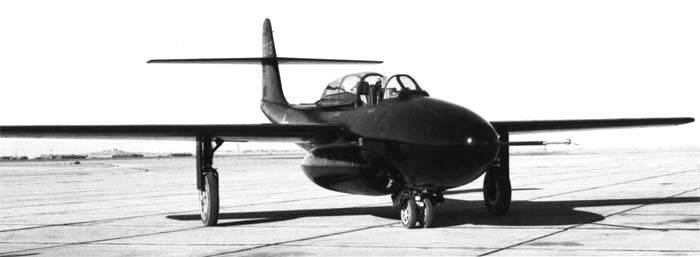
Even before the first flight of the Northrop fighter, 11 on June 1948, the designation system of fighters of the USAF was changed, and the aircraft was renamed accordingly XF-89.
Following the check of the brakes and taxiing at the Northrop airfield, the plane was dismantled and taken to the dried Lake Murok (the future Edwards Air Base). His first flight of the XF-89 made 16 August 1948, under the control of test pilot Fred Bratcher. Flight tests were generally successful, but the aircraft clearly lacked engine thrust. During the first 32 flights on the plane, ordinary ailerons stood, but 1 in February 1949 put the “deceleroons” developed at Northrop on the plane, capable of operating both as ailerons and air brakes. "Deceleron" were placed in the future on all F-89.
Despite the positive feedback from pilots on the XF-89, the US Air Force still hesitated in its choice. On the XF-89, Curtissa XF-87 or Douglas XF3D-1 "Skaynet"? On the XF-87, the pilot and radio operator sat side by side, which was preferred in the US Air Force, as well as on the XF3D-1. The tandem location of the pilot and operator on the XF-89 caused problems in the interaction of crew members. At the same time, the XF3D-1 was easier to maintain, and the second in terms of this parameter was the XF-87. However, according to the test results, the flight personnel preferred the XF-89, besides having good prospects for further modernization.
Although Douglas could not get a contract for the XF3D-1, the aircraft was nevertheless ordered by the fleet and the Marine Corps, where it was used as a coastal and deck interceptor for many years.
In January, 1949, President Harry Truman officially approved the purchase of the first batch of Northrop fighters for the Air Force. And in March of the same year, F-48 received the official name "Scorpion". This was the offer of Edwards airbase ground staff, who was brought to this view by an aircraft - in the parking lot, the tail part of the fuselage pulled up and the high keel gave it a resemblance to the sting of a scorpion. In September 89, the order was extended to 1949 machines.
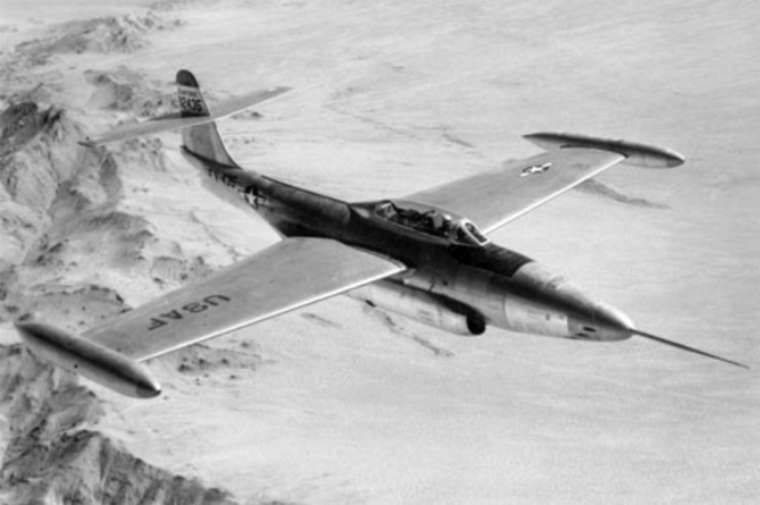
The second prototype was circled 15 on November 1949 of the year. It was almost a serial version of the future fighter F-89, as a result of which its designation was changed to YF-89. If the XF-89 was painted black, then the second copy of the interceptor was all the color of natural duralumin.
The prototypes were not armed because the planned bow tower was not ready for them. However, such an armament scheme was considered too difficult for the interceptor and on the serial "Scorpions" they provided for the more usual armament of the six X. NUMX 20-mm cannons installed in the nose.
Since the US Air Force urgently needed an interceptor, the production of "Scorpion" was deployed before the completion of the full test cycle. This decision was hasty: 22 February 1950 of the year XF-89 crashed on its 102-m flight. The cause of the accident was a strong stabilizer flutter. As a result, YF-89 had to be urgently finalized, and the mass production of the F-89A was suspended.
Forced flight test delay YF-89 was used for extensive modernization of the aircraft. The nose part was completely redone - it became less sharp, and its length increased by 90 cm. In the nose part, we installed the AN / ARC-33 locator and the Hughes E-1 fire control system. The aircraft also installed the Allison J35-A-21 engines using 2360 kg and 3087 kg afterburners. For the new engine, the air intakes had to be redone, surfaces were installed on them to prevent the boundary layer from getting into the engine channel, and they also equipped additional side doors that supply the engine with air on the parking lot. The pitot tube was mixed from the keel to the nose fairing. The dumped tanks at the wing tips of the XF-89 were replaced with permanent tanks with the same capacity in the 1137 l, but of a more streamlined shape.
The refined YF-89 was given the designation YF-89 (“N-49 model”), and re-launched 27 June 1950 of the year. By the time of the accident, the three F-89s were almost ready. It was decided to use these aircraft as experienced until all problems with the Scorpion were solved.
The first serial F-89A was handed over to the USAF 20 September 1950 of the year, and a few weeks later two other cars were handed over.
From the YF-89A serial F-89A different installation of weapons - six 20-mm T-31 guns (M-24) with 200 shells on the barrel. A suspension was also provided for under the wing before 16 rockets or 1450 kg bombs. In the nose, the AN / APG-33 locator was also installed.
We managed to get rid of the flutter by installing additional external balancers on the elevator hinges. Also changed the shape of the heat-resistant screen at the nozzles of the engines under the fuselage, and tested several options. The shape of the rear fuselage immediately behind the engine nozzles was unsuccessful, and at high speeds on the YF-89А because of this there was a sharp increase in air resistance. After all the necessary improvements in January 1951, the assembly of the serial F-89A was resumed.
Actually, however, only eight F-89s were able to be built, and the remaining 40 machines for the first order for mass production were completed in the F-89В and F-89С versions. External balancers on the first F-89А later, replaced by internal, in the image installed on the F-89С. Several worn-out F-89A, later retrofitted to the radio-controlled targets DF-89A. After the release of eight F-89s, the F-89V went into series. The main difference from the “A” modification was the installation of the auto pilot Lir F-5, and the Sparry “Zero-Reader” (an artificial horizon combined in one device, a magnetic compass and an altimeter). Armament and radar equipment remained unchanged.
The first serial F-89В was adopted by the Air Force in February 1951, and it entered service for the 84 squadron of fighter-interceptors in June. Operation of the F-89B as part of the US Air Force did not last long - by 1954, all vehicles of this modification were handed over to the National Guard Air Force. First, on the F-89B, the 176-I squadron of National Guard interceptor fighters re-armed, as part of the 128-second wing at the Wisconsin airbase.
Several outdated F-89В were later converted into radio-controlled targets DF-89В. The first large-scale version of the Scorpion was the F-89C. The first F-89 was circled 19 September 1951 of the year. From F-89A, B - it was distinguished by greater reliability of the systems - in fact, only this variant became the first combat-capable modification of the Scorpion.
Most of the improvements F-89C related to internal equipment. Drainage valves were embedded in the fuel system to prevent the explosion of kerosene vapor. Tanks at the ending were equipped with drain pipes. Improved turbo cab pressurization system. A vertical gyro has been added to the autopilot channel. In January, the 1952, the 74-I interceptor fighter squadron at the Presquay Isl airbase in Maine, armed with F-89C, was declared combat-ready. Soon other interceptor units began to enter service.
Although during the entire 1952 of the year, the Scorpions arrived in combat squadrons, the aircraft continued to pursue engine failures. The first F-89C series (20 machines) was equipped with J35-A-21 engines. This engine was unreliable and often failed. As a result, the F-89C, and later the F-89А / B, were reequipped with more reliable J35-A-21A engines. Somewhat later, the Allison J35-А-33А engine began to put the fighter 2542 kg (3360 kg afterburner) on the fighter. These engines were not only more powerful, but also equipped with new air intakes, with an anti-icing system and new attachment points to the airframe. Since the engines on the F-89 were mounted very low, foreign objects were constantly falling into their air intakes from the runway. To get rid of this, on the J35-A-33A installed retractable lattice screens.
But soon more serious problems appeared. During the 1952 of the year, several F-89s crashed due to faulty wing structures. In the spring and summer of 1952, at least six aircraft crashed. One of them crashed in the eyes of thousands of viewers during an international aviation exhibition in Detroit. After that, flights were banned on all Scorpions, until the causes of accidents were identified.
After a series of intensive flight tests, the previously unknown aerodynamic phenomenon, called aeroelasticity, was revealed. This effect manifested itself during maneuvering with a large overload, when the wing consoles began to sway, which led to the breakdown of its power set. Large fuel tanks at the wing tips only reinforced this phenomenon. All previously released 194 F-89A, B and C were sent back to Northrop, where their wing was reinforced with steel plates. In addition, on the outside of the end fuel tanks, small stabilizers were installed, which reduced tank oscillations during sharp maneuvering.
The total work on strengthening the wing of all F-89С took 14 months, so that the previous number of combat-ready "Scorpions" was achieved only by 1954 year. Immediately from the factory "Scorpions" were distilled into combat units. After all the improvements, F-89С became the most reliable and safe combat aircraft of the USAF. So, the 74-I fighter-interceptor squadron, transferred in August 1954 to the Thule airbase in Greenland, during the year did not have a single incident with its Scorpions. From 1952, the F-89C were in service with the 27, 74 and 433 squadron of interceptor fighters. In 1953, the F-89s retooled the 57 squadron in Iceland, the 65 th and 66 th squadron in Alaska and the 438 th squadron in the States.
With the armament of the US Air Force, the F-89С began to be removed from the 1954 of the year, when new aircraft modifications appeared. F-89C transmitted to the Air Force National Guard. All they armed seven squadrons. Here the F-89C lasted until the sixties, when they were finally removed from service.
To be continued ...
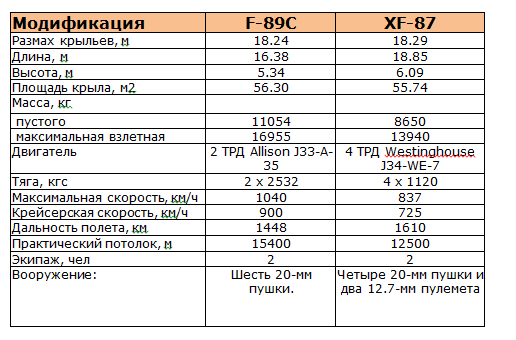
Sources:
Kolov G. "Scorpion" with a nuclear sting // Planes of the world. 2000. No.1. C. 26-32.
Zharkova A. Northrop F-89 "Scorpion". US Night Guard // World Aviation. No.213. C. 8-10.
Firsov A. US Fighters // Aviation Collection. No.14. C. 4-8.
Green V., Cross R. Jet aircraft of the world. M .: Voenizdat, 1957. C.187-189.
Winchester J.. Jet fighters. M .: Astrel, 2013. C. 58-64.
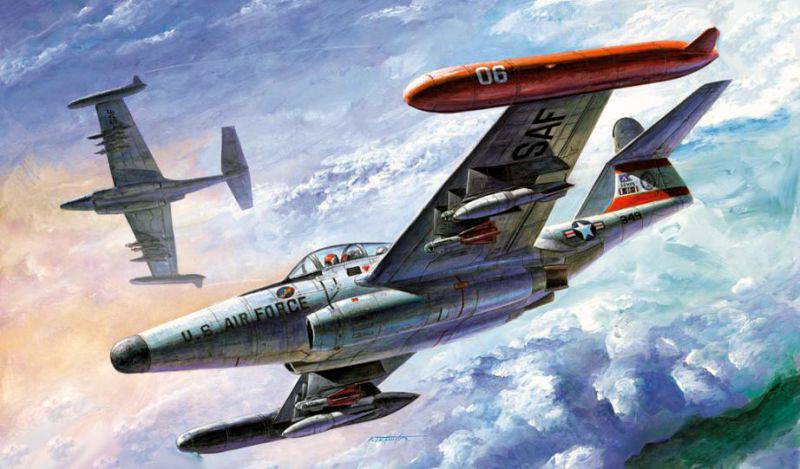
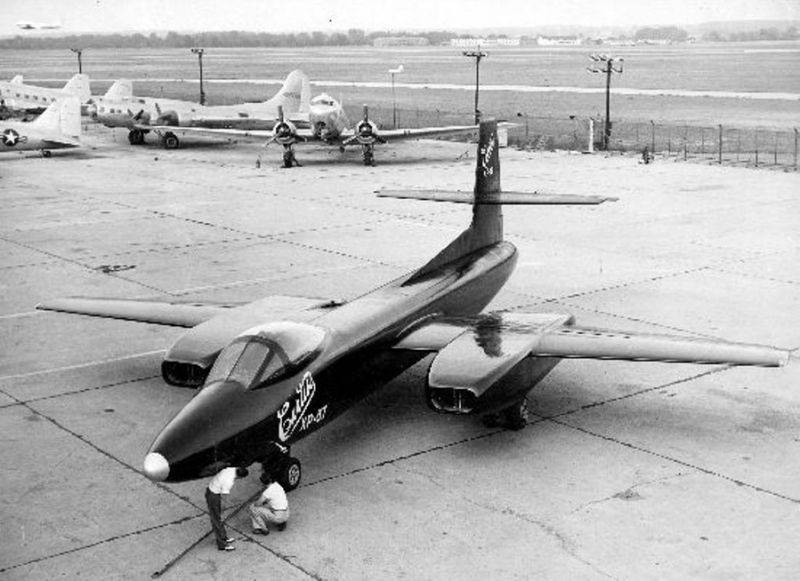
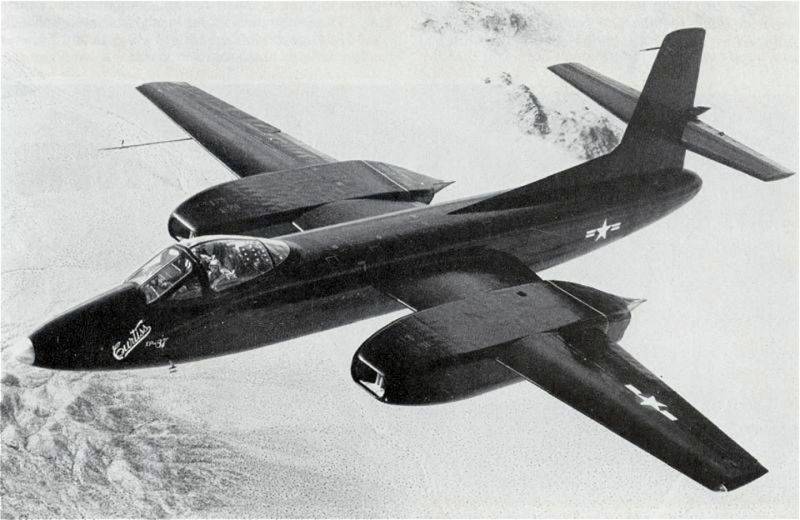
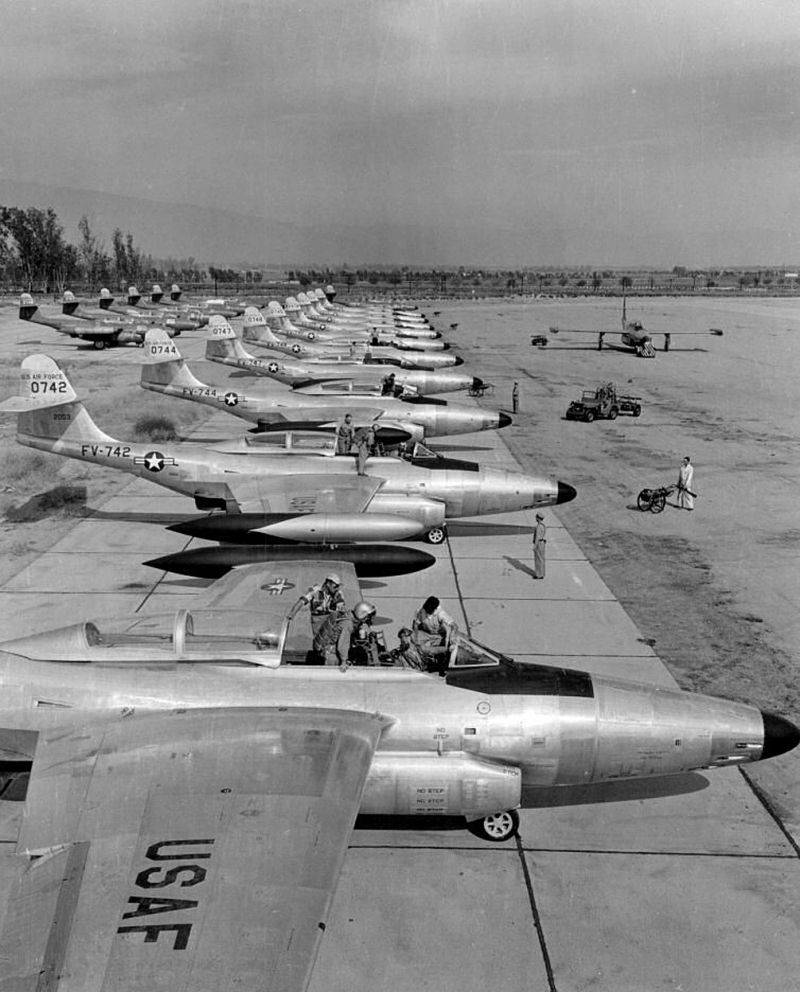
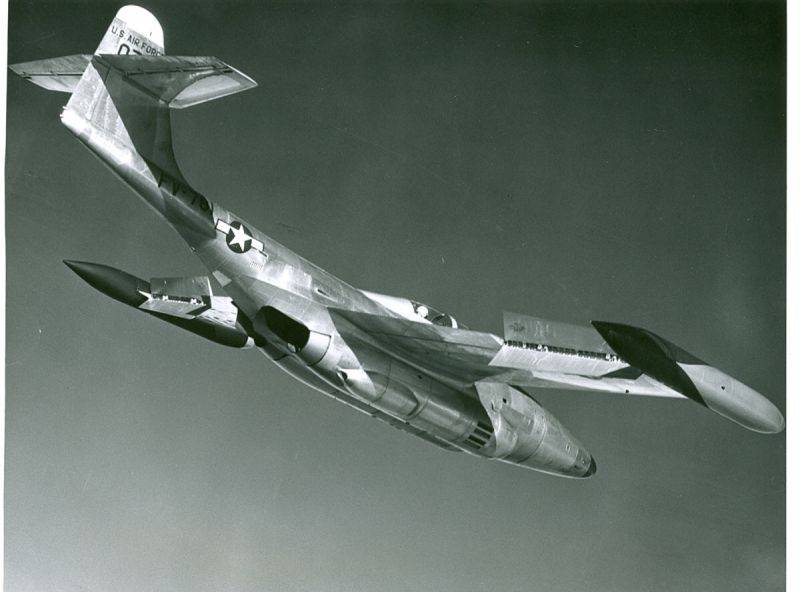
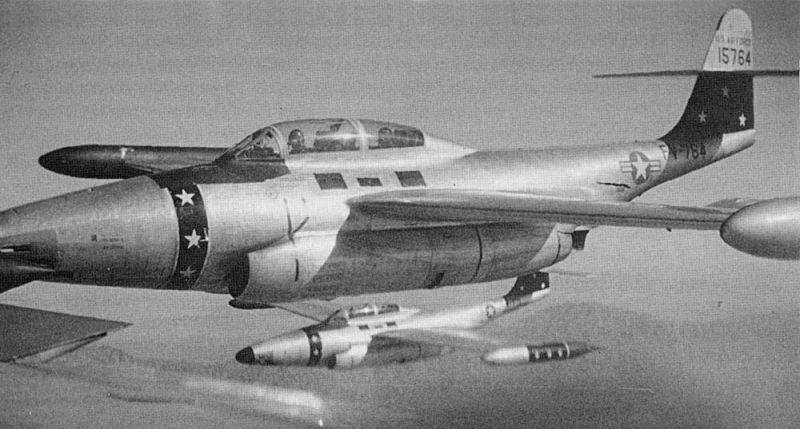
Information